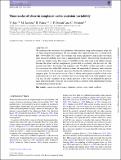Files in this item
Time-scales of close-in exoplanet radio emission variability
Item metadata
| dc.contributor.author | See, Wyke Chun Victor | |
| dc.contributor.author | Jardine, M. | |
| dc.contributor.author | Fares, R. | |
| dc.contributor.author | Donati, J.-F. | |
| dc.contributor.author | Moutou, C. | |
| dc.date.accessioned | 2015-08-13T09:40:03Z | |
| dc.date.available | 2015-08-13T09:40:03Z | |
| dc.date.issued | 2015-07-11 | |
| dc.identifier | 209398239 | |
| dc.identifier | 2f57eea8-daba-49c4-8160-1a3b292cde3d | |
| dc.identifier | 84938118417 | |
| dc.identifier | 000360824000073 | |
| dc.identifier.citation | See , W C V , Jardine , M , Fares , R , Donati , J-F & Moutou , C 2015 , ' Time-scales of close-in exoplanet radio emission variability ' , Monthly Notices of the Royal Astronomical Society , vol. 450 , no. 4 , pp. 4323-4332 . https://doi.org/10.1093/mnras/stv896 | en |
| dc.identifier.issn | 0035-8711 | |
| dc.identifier.other | ORCID: /0000-0002-1466-5236/work/57821878 | |
| dc.identifier.uri | https://hdl.handle.net/10023/7205 | |
| dc.description | VS acknowledges the support of an STFC studentship. RF acknowledges support from STFC consolidated grant ST/J001651/1. | en |
| dc.description.abstract | We investigate the variability of exoplanetary radio emission using stellar magnetic maps and 3D field extrapolation techniques. We use a sample of hot Jupiter hosting stars, focusing on the HD 179949, HD 189733 and τ Boo systems. Our results indicate two time-scales over which radio emission variability may occur at magnetized hot Jupiters. The first is the synodic period of the star-planet system. The origin of variability on this time-scale is the relative motion between the planet and the interplanetary plasma that is corotating with the host star. The second time-scale is the length of the magnetic cycle. Variability on this time-scale is caused by evolution of the stellar field. At these systems, the magnitude of planetary radio emission is anticorrelated with the angular separation between the subplanetary point and the nearest magnetic pole. For the special case of τ Boo b, whose orbital period is tidally locked to the rotation period of its host star, variability only occurs on the time-scale of the magnetic cycle. The lack of radio variability on the synodic period at τ Boo b is not predicted by previous radio emission models, which do not account for the co-rotation of the interplanetary plasma at small distances from the star. | |
| dc.format.extent | 10 | |
| dc.format.extent | 6271289 | |
| dc.language.iso | eng | |
| dc.relation.ispartof | Monthly Notices of the Royal Astronomical Society | en |
| dc.subject | Planet–star interactions | en |
| dc.subject | Planetary systems | en |
| dc.subject | Stars: winds, outflows | en |
| dc.subject | QB Astronomy | en |
| dc.subject | QC Physics | en |
| dc.subject | NDAS | en |
| dc.subject.lcc | QB | en |
| dc.subject.lcc | QC | en |
| dc.title | Time-scales of close-in exoplanet radio emission variability | en |
| dc.type | Journal article | en |
| dc.contributor.sponsor | Science & Technology Facilities Council | en |
| dc.contributor.sponsor | Science & Technology Facilities Council | en |
| dc.contributor.institution | University of St Andrews. School of Physics and Astronomy | en |
| dc.identifier.doi | 10.1093/mnras/stv896 | |
| dc.description.status | Peer reviewed | en |
| dc.identifier.grantnumber | ST/J001651/1 | en |
| dc.identifier.grantnumber | ST/M001296/1 | en |
This item appears in the following Collection(s)
Items in the St Andrews Research Repository are protected by copyright, with all rights reserved, unless otherwise indicated.

